Message from the director of the Western and Central Africa Division
In the context of IFAD’s work to “enable rural poor people to overcome poverty”, increased management efficiency, flexibility and adaptability means that more people will derive greater benefits from IFAD-supported projects than they would otherwise.
To make an impact on reducing rural poverty, IFAD-financed programmes and projects must be managed in the most effective way possible. This calls for competent people, equipped with the latest knowledge in project management both at the programme and project level as well as government institutions, NGOs and partners involved in implementing IFAD-supported activities. Capacity building is therefore crucial.
The portfolio review of IFAD programmes and projects in Western and Central Africa revealed that weak management capability was contributing to low performance levels in over 20 per cent of them. Similarly, during project implementation workshops held in 2002 in Cotonou, Benin and in 2004 in Bamako, Mali, staff and project managers acknowledged the importance of improving their management skills to increase project performance.
Recognizing that management capacity is a major implementation constraint, the Division launched the Management Capacity Strengthening Programme (MSCP). The start-up workshop of the MSCP, which is administrated by the West Africa Rural Foundation, marked a milestone in improving the management of IFAD-financed projects. The programme is quite original as it is cofinanced by an IFAD grant as well as project loans. The MSCP aims at improving the management capacity of IFAD-supported project teams, government counterparts, NGOs and partners. It partners with regional institutes to build their capacity to deliver training programmes in management for rural development.The MSCP will provide appropriate and practical training to solve crucial and daily management issues faced by the projects.
Still other challenges remain. The Division is preparing a new initiative to provide additional assistance in the field of monitoring and evaluation addressing concerns related to results-based measurement of IFAD’s activities in the region.
IFAD’s emphasis on capacity building complements other IFAD support in the countries. In today’s development context, capacity building is needed for promoting country-specific solutions to rural poverty reduction. The intention for IFAD is to remain engaged, and the strategy in this particular domain will continue to be guided by a commitment to make the support of IFAD and its partners as effective as possible.
Mohamed Béavogui
Global Forum on Agriculture
 The main objective of the Global Forum on Agriculture, held in Paris from 16 to 17 May 2006, was to identify and evaluate the constraints to the development of sub-Saharan African agriculture. The forum promoted dialogue between agriculture and development specialists and between member countries of the Organisation for Economic Co-operation and Development (OECD) and African stakeholders.
The main objective of the Global Forum on Agriculture, held in Paris from 16 to 17 May 2006, was to identify and evaluate the constraints to the development of sub-Saharan African agriculture. The forum promoted dialogue between agriculture and development specialists and between member countries of the Organisation for Economic Co-operation and Development (OECD) and African stakeholders.
Participants expressed concern over the limited voice of producers and other civil society stakeholders in policy formulation. Empowerment of these groups is fundamental to local acceptance of national and regional policies. Many of the African participants emphasized that there is a strong desire for a “made in Africa” agricultural policy consistent with national objectives. A lack of information and analysis was seen as a severe limitation to effective decision-making. New policy analyses under way in the OECD/IFAD/France Support to African Agriculture Project (SAAP) and the FAO Agriculture Policy Indicators (API) project stressed that agricultural policies, development aid and institutional constraints needed to be examined together. The objective of these coordinated efforts is to provide some quantitative measurement of policy distortions and policy reforms.
The forum concluded that reforms are needed to increase per capita production and food availability. While existing technologies can go a long way towards addressing these production problems, increased research and agricultural extension services are required to take full advantage of the natural and human resources available. There is also a need for greater awareness of broader economic, social and political conditions.
A consensus emerged that agricultural policy evaluation and impact analysis should be undertaken in the context of broader economic and social objectives including rural development and poverty reduction.
For more information, please contact: Jean-Paul Pradere
IFAD at the Africa Fertilizer Summit
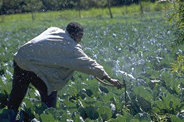 About 1,100 participants including 7 African heads of state, 15 ministers of agriculture, 17 eminent persons and hundreds of leaders of international organizations, agricultural research centres, and private-sector companies took part in the Africa Fertilizer Summit organized in Abuja, Nigeria by the African Union (AU), the New Partnership for Africa’s Development (NEPAD) and the Government of the Federal Republic of Nigeria from 9 to 13 June 2006. The summit aimed to boost fertilizer use across the continent and trigger a Green Revolution in Africa.
About 1,100 participants including 7 African heads of state, 15 ministers of agriculture, 17 eminent persons and hundreds of leaders of international organizations, agricultural research centres, and private-sector companies took part in the Africa Fertilizer Summit organized in Abuja, Nigeria by the African Union (AU), the New Partnership for Africa’s Development (NEPAD) and the Government of the Federal Republic of Nigeria from 9 to 13 June 2006. The summit aimed to boost fertilizer use across the continent and trigger a Green Revolution in Africa.
In the Abuja Declaration on Fertilizer for an African Green Revolution issued at the end of the summit, African leaders declared fertilizer, from both inorganic and organic sources, “a strategic commodity without borders” and resolved that “the African Union Member States will accelerate the timely access of farmers to fertilizers”. Twelve key measures to foster an African Green Revolution were adopted.
The first of these was a resolution by the AU member states to increase the level of fertilizer use from the current average of 8 kilograms per hectare, to an average of at least 50 kilograms per hectare by 2015. As an immediate measure, the declaration recommended “the elimination of taxes and tariffs on fertilizer and on fertilizer raw materials”.
The summit also agreed on an action plan to translate the declaration into concrete action. The action plan has five main elements:
- development of agro-dealer networks across rural Africa
- establishment of national agricultural input credit guarantee facilities
- use of “smart” subsidies to ensure that poor smallholders have access to fertilizers
- creation of regional fertilizer procurement and distribution centres, removal of trade barriers and promotion of local fertilizer production
- establishment of an Africa Fertilizer Development Financing Mechanism by the African Development Bank
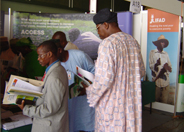 IFAD President Lennart Båge lauded the goals of the summit in his address to the heads of state. “This is your Green Revolution, and the events of the past four days have shown how much will there is across Africa to solve the continent’s problems and to solve them now; in a way that is inclusive, forward-looking and businesslike,” Båge said.
IFAD President Lennart Båge lauded the goals of the summit in his address to the heads of state. “This is your Green Revolution, and the events of the past four days have shown how much will there is across Africa to solve the continent’s problems and to solve them now; in a way that is inclusive, forward-looking and businesslike,” Båge said.
IFAD took part in the Africa Fertilizer Summit to ensure that the needs of African smallholders, particularly the poorest, are taken into account in regional and national action plans drawn up to boost fertilizer use. IFAD was a major sponsor of the summit, along with partners such as the Rockefeller Foundation and the United Kingdom’s Department for International Development.
Read the statement by IFAD President
Progress in executing the Bamako Action Plan
The Bamako Action Plan was developed at the Regional Project Implementation Workshop in March 2005 to enhance IFAD’s performance in Western and Central Africa. The action plan focuses on strengthening monitoring and evaluation (M&E) systems; improving the performance of service providers; raising disbursement rates; and strengthening project management capacity. The action plan also supports IFAD’s move towards a country programme approach by improving information exchange and communication, knowledge management, partnership and policy dialogue.
There has been major progress in implementing 16 of the 22 actions that were identified and discussed at the Regional Project Implementation Workshop in March 2005, and efforts to achieve the targets by its final review in 2007 can be considered on track. The main highlights so far are related to efforts being made to:
- harmonize M&E tools
- strengthen the M&E capacities of project teams and provide appropriate support to carry out M&E activities
- provide technical support on a systematic basis to projects with identified management problems
- standardize annual work programme and budget formats as a planning tool for improving project-level implementation
- improve management capacity
To strengthen the M&E systems, a regional familiarization workshop was organized in Burkina Faso in September 2005. Progress has also been made in the development of an M&E Capacity Strengthening Programme adopting a similar approach to the Management Capacity Strengthening Programme (MSCP) managed by the West African Rural Foundation (WARF). The MSCP start-up workshop held in Dakar in June 2006 marked a milestone in the improvement of management capacity in IFAD-financed projects. A subsequent workshop on loan administration (held in Niamey, also in June 2006) focused specifically on fiduciary aspects in the portfolio supervised by the West African Development Bank (BOAD) and UNOPS.
Progress has also been made regarding partnerships with farmers’ organizations and their effectiveness in policy dialogue, as well as in improving access to and exchange of information and knowledge to support country programme performance. FIDAFRIQUE is increasingly recognized as a key player in the effective sharing of knowledge through its support to communications and to the preparation and follow up of regional workshops, e-discussions and electronic forums on key thematic areas related to the regional portfolio, including community-driven development, rural finance and market access (with particular attention to cassava). Both the Division and FIDAFRIQUE have launched quarterly newsletters.
Some progress has also been made in involving key stakeholders more systematically in the country programme planning and implementation cycle by organizing round-table discussions, mainly in the context of COSOP processes (Burkina Faso, Ghana). This has included particular attention to supporting farmers’ organizations, which was provided through grants in Burkina Faso and Mali.
There are still major challenges with regard to moving towards a more coherent country programme approach, where the performance targets are less tangible. Increased attention to these areas will be required to ensure not only delivery but also the desired impact of the Bamako Action Plan.
For more information, please contact: Ulac Demirag
Stories from the field
Unlocking farmers’ best-kept secrets: a joint WARDA-IFAD project helps document and properly value local knowledge and innovations
| Tools to classify knowledge and understand knowledge flows | ||
Knowledge matrix: This tool helps to classify the people’s knowledge on any subject into four types: deep, shallow, mistaken and missing. Based on this, appropriate interventions can be developed. For instance, if farmers have deep knowledge about controlling an insect pest, this is the place where local innovations are likely to be plenty and where scientists can learn from them. Local names: What’s in a name? It is important to remember that local names often tell a story or summarize a local problem. For example, in some parts of Ghana, rice off-types are known as Modiak, ormale rice. This has a negative connotation because rice is considered a female crop, a life giver. Well-being analysis: The poorest people are often forced to innovate to survive. The well-being analysis allows farmers to identify the poorest sections in their own community. In the project, this tool is also used to evaluate the social dimensions of farmer-to-farmer extension and to measure the impact of its interventions. |
||
Did you know that you can get rid of termites by smoking them out with tobacco leaves; that if rice seeds are dressed with wood ash, they can be safely stored; or that tethering of livestock in cereal fields can help reduce Striga infestation in those fields?
If you haven’t heard of these simple solutions, you are not the only one. Quite a few agricultural researchers and extension workers are also not aware of them. These are some of the little known local “best practices” that are being identified, validated and documented, thanks to the project Participatory Adaptive Research and Dissemination of Rice Technologies in West Africa (PADS Phase II).
The project is designed to improve rice productivity, stimulate crop diversification and increase farmers’ incomes in inland valley systems. With support from IFAD, the project is being carried out by the Africa Rice Center (WARDA) and its partners in four West African countries – the Gambia, Ghana, Guinea and Mali.
The project will identify, evaluate, enhance and scale up sustainable innovations – not only from research institutes, but also home-grown solutions developed by farming communities.
The three-year project proposes one key theme each year. In 2005, the focus was termite control. In 2006, special attention is being given to weed control in inland valleys. So far, more than 30 local innovations have been documented.
A major challenge of PADS is to change the mindset of the people who work with farmers. “Most of us automatically assume that scientists are the sole source of innovation in agriculture,” says Paul Van Mele, a WARDA technology transfer specialist who leads the project. “We tend to forget that farmers play a significant role as local innovators capitalizing on their day-to-day experience,” he explains. Their knowledge is often lost over time or remains locked up in the memories of individual families and communities because of the lack of a suitable mechanism for dissemination.
| Techniques to collect and document local innovations | ||
Interviewing techniques: During the workshop, participants learn how to listen to farmers and use open-ended questions to elicit useful answers from them. Documenting techniques: The art of storytelling is a valuable skill for describing and documenting local innovations in a more reader-friendly way. Awards: How to motivate people to write? An external team of experts has been identified that will select the three best stories submitted to the project. Financial prizes will be issued to the winning national teams. Validation criteria: Participants from diverse backgrounds learn to identify the local innovations that are worthwhile to disseminate, using such criteria as whether the innovations are sensitive to local cultures; safe; environmentally friendly; likely to be accepted; and whether the required materials are readily available. Tools for scaling out: Towards the end of the workshop, participants explore the advantages, drawbacks and potential of various extension methods, and develop action plans for large-scale dissemination of local innovations and underlying scientific principles. |
||
The project will select some of the most successful and widely applicable local innovations and disseminate them through the media and farmer-to-farmer extension services. “Some of these local innovations may even be taken up by scientists as researchable topics,” Van Mele comments.
How are these local innovations found? Once identified, how are they documented? Finally, on what bases are particular innovations selected as most suitable for scaling up?
To address such questions, four training workshops for project coordinators, extension workers, scientists and NGOs were held in 2005-2006 in each of the participating countries. The workshops concentrated on concepts, tools and techniques to better understand farmers’ perceptions and innovations.
“One interesting finding from the project is that we realized that people in developing countries often face similar challenges,” observes Van Mele. He noted, for example, how four videos about on-farm management of rice seed health made in Bangladesh with rural women have become a big hit in many African villages.
The project not only facilitates the sharing of knowledge and innovations between communities and regions, but also institutionalizes pro-poor research and development processes. During the project advisory committee meeting in April 2006 in Kumasi, a set of criteria to identify those local innovations with the highest regional diffusion potential was developed and tested. Ways to weave local innovations into participatory learning and action research activities and media programmes were elaborated upon.
For more information, please contact: Luyaku Loko Nsimpasi or Paul Van MeleCameroon: transforming kola nuts from cultural treasure to lucrative commodity
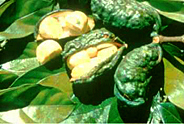 In central Africa, it is said that he who brings kola, brings life. Yet, until recently, kola had not been deliberately planted. The World Agroforestry Centre and its partners are working hard to transform kola from a cultural treasure into a viable commodity by domesticating the tree using vegetative propagation to ensure high quality nuts. The Centre is also examining ways to reduce post harvest losses and empower producers.
In central Africa, it is said that he who brings kola, brings life. Yet, until recently, kola had not been deliberately planted. The World Agroforestry Centre and its partners are working hard to transform kola from a cultural treasure into a viable commodity by domesticating the tree using vegetative propagation to ensure high quality nuts. The Centre is also examining ways to reduce post harvest losses and empower producers.
For all its cultural and even medicinal importance, little has been done to develop the kola nut into a tree commodity with a formal and clearly structured market chain. This is due, in part, to the fact that the tree grows extremely slowly, often not fruiting for 20 years.
“After these 20 years, the tree may turn out to be a male tree that does not produce fruit,” says Ebenezar Asaah, a tree improvement specialist with the World Agroforestry Centre, Humid Tropics. For these reasons many farmers lost interest in cultivating the tree.
With support from IFAD, and in concert with its national research partners and community-based and farmer groups in Central Africa, the Centre took up the challenge in 1998 to develop workable techniques to bring valuable trees from the forest or wild stands into the nursery, where they are replicated and multiplied using marcotting, grafting and rooting of cuttings.
In the agroforestry nurseries that have multiplied throughout the region, farmers themselves are now producing these kola planting materials. According to Anthony Bangha, head of the Ijim Farmers’ Union in the community of Dichami in Cameroon’s mountainous Northwest province, prices for the nuts vary by a factor of four during the year. Bangha’s farming group is already producing kola marcotts from the best trees they could find or from individual trees that fruit off-season. They are integrating these materials into their coffee-based farming systems.
To complement the domestication research on kola, the Centre turned its attention to the complex business of growing and selling kola nuts. With financial support from the Belgian Directorate General for Development, researchers have been analysing the intricacies of the informal market and working to develop a “Farmer Enterprise Network”. It will help producers of kola nut organize themselves and generate the most income possible from the nuts they are beginning to produce from these high quality domesticated trees.
Researchers from the Centre and the Hass Business School of the University of California, Berkeley, identified actors of the kola market chain. The chain goes from the nursery operator to the farmer through the collector and wholesaler and then to the retailer in the market who finally sells the kola nut to the consumer.
A detailed look at production costs revealed that a major problem faced by farmers was post-harvest losses to pests such as the weevil (Balanogastric kolae), which attacks poorly stored nuts, forcing farmers to sell their kola harvest early on, when prices were low.
To find ways of increasing the profitability of kola cultivation by reducing post-harvest losses, researchers joined forces with the Ijim Farmers’ Union to conduct experiments that improved on traditional storage methods. Baskets covered by banana leaves were adapted by layering the nuts in different kinds of leaves with insect-resistant properties. Vetiver, eucalyptus, cypress, tobacco and a control with no treatment properties were all tried.
“We have found that the best way to store the nuts, if you want to sell them when prices are high, is to put them in baskets with vetiver leaves,” concludes Bangha. “And make sure the pods are not split, humidity and light are kept to a minimum to reduce pests and prevent germination.”
Market research studies have shown that a farmer with 40 to 50 high quality trees on a farm can sell 1 million CFA (about US$1,900) a year, if storage is good.
The Centre’s multi-pronged approach to developing kola as a lucrative commodity with a strong regional market capable of handling increased future production of high quality nuts by well organized farmers should go a long way to capitalize on this local resource.
Source: World Agroforestry Centre, “Agroforestry in action” series, document reference – 2005-16-Trees and Markets – African Humid Tropics - Title: Adding value to tradition.
For more information, please contact: Catherine Momha
Benin’s avlékététin: community-owned spawning grounds
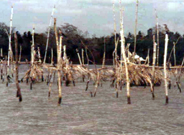 Lake Ahémé and the adjacent coastal lagoon in southwest Benin no longer provide a hospitable environment for fish to reproduce and grow before being caught in open water. Since the Nangbéto reservoir was filled-in, flooding at Lake Ahémé-Chenal Aho and the coastal lagoon occurs more suddenly, does not rise as high and lasts longer than before. As a result, floodwaters recede more quickly, the floodplain dries out sooner and opportunities for fish to reproduce in the lake are now very limited. Fishers, who number more than 100 per square kilometre, have seen their catches dwindle abruptly and their incomes fall.
Lake Ahémé and the adjacent coastal lagoon in southwest Benin no longer provide a hospitable environment for fish to reproduce and grow before being caught in open water. Since the Nangbéto reservoir was filled-in, flooding at Lake Ahémé-Chenal Aho and the coastal lagoon occurs more suddenly, does not rise as high and lasts longer than before. As a result, floodwaters recede more quickly, the floodplain dries out sooner and opportunities for fish to reproduce in the lake are now very limited. Fishers, who number more than 100 per square kilometre, have seen their catches dwindle abruptly and their incomes fall.
Originally, the avlékététin spawning grounds of Lake Ahémé were small circular pens about 15 metres in diameter where traditional leaders made animal sacrifices and rituals to entreat the lake to yield up its fish. These protected areas instituted by traditional religious leaders possess an important biological potential for building up resources in lakes and rivers. They have served as a refuge for fish and as a place for reproduction and feeding of minnows while safeguarding biodiversity. By tradition, no one is allowed to fish in these sacred areas. Fishers are required to cast their lines at a distance of at least 100 metres from the spawning ground. However, as traditional authorities have weakened, so has the enforcement of these rules. Rehabilitating natural spawning grounds is an indigenous technology that can be used to restock watercourses. Local people oversee the spawning grounds ensuring that production continues to grow and provide incomes for fishers and their wives. |
||
Restoring biological reserves has become an imperative in rehabilitating the water resources that provide a livelihood for thousands of local residents. The rehabilitation of spawning grounds began in December 1999 under the aegis of the Directorate of Fisheries, with financing from the Wetlands Management Programme, and continued in 2001 with financing from the public investment programme.
Spawning grounds in aquatic ecosystems provide a safe habitat for female fish to deposit their eggs for fertilization by male milt. Reproduction can then take place without exposing the larvae to predators. Today, the only favourable environments for reproduction and growth of fish species are natural spawning grounds, the avlékététin that provide places of refuge.
The Participatory Artisanal Fisheries Development Support Programme includes rehabilitating natural spawning grounds among its activities, and work was completed on 30 of them in 2004 at Lake Ahémé. Following many meetings held with local elected officials, traditional leaders and fisher representatives, it was decided the spawning grounds would be protected by planting stakes to prevent fishers from casting in their lines. The traditional circular shape was maintained with a diameter of 50 to 75 metres. This allows for a larger available protected surface area to increase production.
Data gathered from residents around Lake Ahémé since the rehabilitation work was done indicate that results are already positive in terms of the quantity, size and biodiversity of fish caught.
For more information, please contact: Gérard Gnakadja, [email protected]
Mali: a gold medal for FODESA
The Swiss Foundation for Excellence in Business Practice awarded a gold medal to the Sahelian Areas Development Fund Programme (FODESA) at its tenth forum held from 9 to 11 March 2006 in Geneva.
Mali’s Minister of Agriculture Seydou Traoré took advantage of the opportunity to express his personal appreciation, and that of his country, to IFAD President Lennart Båge for the Fund’s important efforts to improve living conditions for the most vulnerable. He added that the medal stood as testimony of the Fund’s steadfast support.
Founded in Mali in 1999, FODESA seeks to increase incomes and improve living conditions for 72,000 families in the regions of Koulikoro, Ségou and Mopti. The programme is fully managed by village associations and is being implemented over a ten-year period.
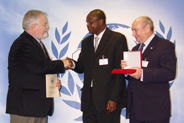 The Foundation for Excellence in Business Practice falls under the oversight of the Swiss federal authorities and was set up to impart internationally recognized standards of operations and promote the practice of excellence. The Foundation awards distinctions to organizations, private and semi-public enterprises, projects, associations and nongovernmental organizations that have performed at an outstanding level. Performance is measured by the quality of services provided or products delivered, the impact of results achieved, and the trust and reputation accorded the organizations in their own environment.
The Foundation for Excellence in Business Practice falls under the oversight of the Swiss federal authorities and was set up to impart internationally recognized standards of operations and promote the practice of excellence. The Foundation awards distinctions to organizations, private and semi-public enterprises, projects, associations and nongovernmental organizations that have performed at an outstanding level. Performance is measured by the quality of services provided or products delivered, the impact of results achieved, and the trust and reputation accorded the organizations in their own environment.
For more information, please contact: Fatogoma Diarra
News and events
IFAD builds management capacity among its project teams
IFAD’s effectiveness in project implementation is the cornerstone of its strategy on behalf of rural poor people in Western and Central Africa. Effective projects are crucial if IFAD is to have a tangible and significant impact on combating poverty.
Difficulties with implementing certain projects can sometimes be attributed to inadequate training of team members. To address this, IFAD has set up a four-year management capacity building programme for project team members, at a cost of US$1.5 million.
A workshop was held in Dakar on 7 and 8 June 2006 to launch the programme, which is designed to:
- build coordination team members’ skills to improve their ability to solve problems that may arise in implementing projects
- improve the capacities and relevance of interventions by regional training institutions and trainers in managing rural development projects
This programme is managed and coordinated by the West Africa Rural Foundation and will extend to all IFAD projects in the Western and Central Africa region. Through it, IFAD hopes to boost partnerships between local and regional development institutions and IFAD projects. Three institutions have been identified to carry it out: Institut Supérieur Africain pour le Développement de l’Entreprise Dakar [Higher Institute for Business Development in Africa] (ISADE Sénégal), Management Development and Productivity Institute (MDPI Ghana) and Centre de Formation Continue [Centre for Continuing Education] (CEFOC Burkina Faso).
For more information, please contact: Luyaku Loko Nsimpasi, or Ngagne Mbao
Introducing conservation agriculture to smallholders in Western and Central Africa
Promoting sustainable farming systems is an important element of IFAD’s strategy to combat rural poverty. Most IFAD-financed projects include a soil and water conservation component whereby stakeholders endeavour to maximize soil productivity while sustainably improving fertility. Conservation agriculture is on the rise all over the world and can be summed up in three basic principles: disturb the soil as little as possible; keep the soil covered at all times; and practise crop rotation.
A workshop to design the Smallholder Conservation Agriculture Promotion (SCAP) project was held from 23 to 25 May 2006 at Ouagadougou, organized by IFAD and the Sustainable Rural Development Project. The purpose was to formulate the SCAP project with broad based participation from ten African countries, whose representatives contributed building blocks to put together the project from a technical, institutional and financial point of view.
To consolidate this approach to farming in Western and Central Africa, IFAD asked the African Conservation Tillage (ACT) network to implement a regional project to promote it, based on four IFAD investment projects – two in Burkina Faso, one in Guinea and one in the Niger. In so doing, ACT will work with scientific and technical partners such as Centre de Coopération Internationale en Recherche Agronomique pour le Développement [French Agricultural Research Centre for International Development] (CIRAD) and the World Agroforestry Centre (ICRAF).
The SCAP project hopes to spark a new conservation-based dynamic to complement soil and water conservation initiatives already under way. The project will focus on both technical and social issues, training and knowledge management to strengthen African institutions, groups, networks and organizations engaged in such work. Activities are scheduled to begin in early 2007.
For more information, please contact: Mohamed Manssouri, or Florent Maraux
New US$11.9 million IFAD grant supports sustainable growth in Mali’s fragile river ecosystem
The grant agreement for Biodiversity Conservation and Participatory Sustainable Management of Natural Resources in the Inner Niger Delta and its Transition Area, Mopti Region, was signed on 6 June 2006 at IFAD headquarters in Rome by the President of IFAD, Lennart Båge, and the Ambassador of Mali in Rome, Ibrahim Bocar Daga.
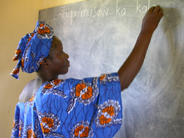 The US$20.5 million project will be financed by a US$11.9 million grant from IFAD within the framework of the Sahelian Areas Development Fund Programme.
The US$20.5 million project will be financed by a US$11.9 million grant from IFAD within the framework of the Sahelian Areas Development Fund Programme.
It is IFAD’s first grant agreement as an executing agency for the Global Environment Facility (GEF). The project will focus on an area of 30,000 square kilometres in the Mopti region, which is flooded for several months every year. This area is one of the few large inner deltas in the world. It is characterized by complex ecosystems and constitutes a unique refuge zone for a large number of migratory birds and other wildlife, including endangered species such as manatees and hippopotamuses.
GEF and IFAD funding for the programme are complementary and will allow linkage between poverty allievation, natural resource management and biodiversity conservation in a region whose ecosystems are of global importance.
A large number of Mali’s population living in the Niger River Inner Delta will benefit from additional resources within the Sahelian Areas Development Fund Programme to address rural poverty and environmental degradation.
Start-up workshop for the Northern Mali Investment and Rural Development Programme
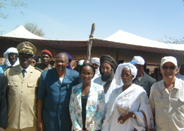 A workshop was held in Timbuktu from 8 to 10 May 2006 to launch the Northern Mali Investment and Rural Development Programme (PIDRN). On the following day, President Amani Toumani Touré of the Republic of Mali presided over a ceremony to inaugurate the programme’s activities.
A workshop was held in Timbuktu from 8 to 10 May 2006 to launch the Northern Mali Investment and Rural Development Programme (PIDRN). On the following day, President Amani Toumani Touré of the Republic of Mali presided over a ceremony to inaugurate the programme’s activities.
Over the next seven years PIDRN will work to combat poverty among farmers, nomadic herders and other vulnerable groups in the regions of Timbuktu and Gao. Extreme poverty was one of the triggers of the armed conflict that plagued the country’s northern regions during the 1990s. For IFAD’s President, Lennart Båge, this programme bears witness to the Fund’s commitment to lead the efforts deployed in northern Mali, based on the Fund’s experience with interventions in troubled areas.
IFAD is supporting this US$33.6 million programme with a loan for US$14.6 million and a grant for US$803,000. Cofinancing for PIDRN is being provided by the West African Development Bank and the Belgian Survival Fund.
Communication for development and natural resource management
In preparation for the World Congress on Communication for Development to be held in Rome from 25 to 27 October 2006, a subregional workshop on communication for development and natural resource management took place from 6 to 8 June 2006 in Ouagadougou, Burkina Faso. The workshop provided an opportunity for reflection, analysis and an exchange of experiences in communication about natural resource management.
Reflections focused on ways of making communication a full-fledged component of projects and programmes in local development and natural resource management. The plan of action that emerged is built around five strategic thrusts:
- design and implement national policies on communication for development
- build communication for development into projects and programmes, particularly those having to do with natural resource management and local development
- forge strategic partnerships among national, subregional and international institutions operating in these sectors
- build capacity
- value and make use of local knowledge and expertise
